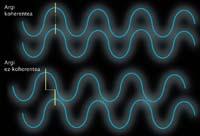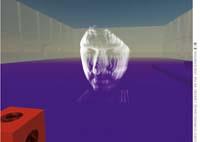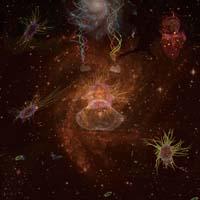Lost dimension in photos

The holography was created in 1947 by the Hungarian physicist Dennis Gabor and received the Nobel Prize in Physics in 1971. His intention was to improve the electronic microscope by means of a photographic record of images. He did not achieve the goal, but he invented an interesting way to obtain images: holography. It took the name of the Greek because holos means 'complete' and holograms show the object in its entirety, not just a perspective. Subsequently, using laser, Emmet Leith and Juris Upatnieks greatly improved the system in the United States in 1963 and Juri Denisiu in the Soviet Union.
The reality between hands
Although it is only a reflection of reality, the hologram keeps the mystery and sweat of scientists, who try to reflect reality.

To do this, as in traditional photography, you first have to take out the photo and then reveal it. The hologram register is also based on two steps: first you have to register on a photographic plate and then, after “revealing” it, you pass a ray of light to form the image of the object. In the case of holograms, photography is the result of interference between light rays.
In holograms this interference is due to the gap between two rays of light. It is said that when two waves go in the same phase, without any lag, they are coherent. In the study of holograms it is essential to know this phase difference between waves. Why is it important to know the phase of a wave? The two waves that start from the same focus with the same phase and with the intention of making the same route or distance, will have the same phase of arrival. However, if the course of these two waves is different, the two are delayed and will not be in phase.
The laser is the source that offers us a truly coherent beam of light. In holograms, laser light is divided into two parts: one part of the beam is used to illuminate the object and the other, called a series of references, attacks the support, the photographic plate or the emulsion. These two rays are in phase. How long? The incident light beam on the surface of the object will collide against the object and therefore the reflected rays will appear out of date. In fact, the beam of light that affects the object is reflected in all points of the object, so each reflected beam appears out of date.

When we observe the hologram, therefore, we can see the object in image dimensions and if we observe that the hologram is moving from one side to the other, we will see that the image changes and we will be able to observe the parts of the image, as if we had seen it in reality, that is, with movement. However, holograms should not necessarily reflect a three-dimensional image. It can happen that two or more images are inserted into one support and see one or the other according to the angle. For example, if we made a hologram of an open book with a magnifying glass above, from each position we could read a certain part of the text.
If these holograms are properly illuminated, they somehow go outside their limits. In addition, depending on the position of the observer, a different image is observed and it is often difficult to maintain the temptation to touch them.
Visible applications

Some applications of holography are so everyday that many people don't realize it. But if you look at the ticket in your hands, you would immediately see the bright band from top to bottom on the back and right. It is a hologram in which when moving the ticket the symbol of the euro and the amount of the ticket appears. Credit and phone cards also show a hologram to check its authenticity.
Perhaps the most well-known and widespread application is security systems: these special images are the usual ones in banknotes, credit cards, identification cards, etc. Although bright and eye-catching, they are not used as ornaments, but to hinder the work of counterfeiters.
One of the most interesting applications of holography is the storage capacity of information. Holographic memory is similar to three-dimensional photography. However, unlike photographic films, several 'images' can be stored in the material of holographic memory, one over the other.
Reference rays emitted from different angles are used for this purpose. Then, to read the 'images', two crossed laser beams are used to retrieve the light model used during writing. The information obtained is in one way or another depending on the angle from which the support is viewed. In this way you can store a lot of information in a small support with which it is expected, among other things, that the memory of the DVDs and their descendants increase considerably.

Holography also serves to unravel the secrets of matter, since molecules can be seen in three dimensions thanks to a technique based on holography. This technique has a huge resolution, around the measurement of an atom approximately. As in other applications, it is about recording the interference between both rays. The rays used, instead of being laser, are x-rays or electrons. Through them you can know the structure of the molecules.

Holography has experienced in recent years an enormous development in fields as diverse as research, medicine, industry or art. We have many known uses and use them in our daily lives. As for art, it doesn't seem to have influenced as much as expected. The painter Salvador Dali was one of the first to use holograms, he always had the desire to create optical illusions in his paintings.
Salvador Dalí himself spoke about holography in April 1972 in New York: "Since the time of Velázquez, all artists have been interested in three-dimensional images. In modern times, Picasso's analytical cubism tried to obtain Velázquez's three dimensions. Now, due to Gabor's genius, holography has achieved the capacity for a new Renaissance of art."
In the era of computer, digitization and virtual reality, in terms of cinema and art, holography has not had the expected development. That does not mean that it has no future, because it has more and more applications.





